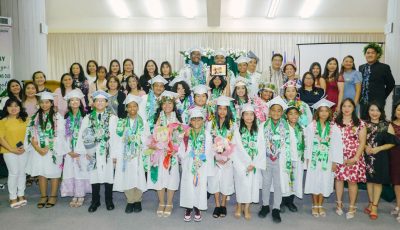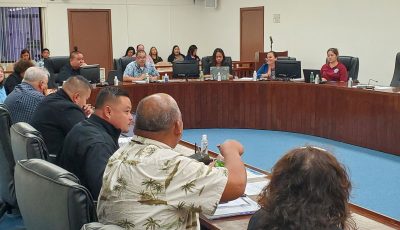PSS: ‘Test the car before you drive it’
The Public School System aims to eventually have 500 to 600 students in their cooperative education program, with a 400-count targeted for school year 2016, according to Christopher Tenorio, interim coordinator of PSS’ cooperative education program.
Tenorio spoke at yesterday’s Saipan Chamber of Commerce general membership meeting, where he stressed the importance of a strong relationship between the business sector and public schools as a labor workforce is built to prepare for the departure of contract workers in 2019.
“We are investing [in students] who will five years from now will be 21, 22, 23 years old, college graduate students,” he said of the benefits of the program.
Tenorio described the co-op program as an “integration” of both classroom and real-world skills, with students required to work two hours at their job sites, with their instructors maintaining an “open line of communication” with employers to ensure the students are meeting performance standards.
He said the co-op first prepares students for a job interview, then students find placement and internships, signing a training agreement between student and guardian, school, and employee to work at their job site during the school year.
He stressed that he has observed a “big disconnect” in teaching high school students how to draft a résumé, write professionally, and interview well.
The co-op program, he said, will help prepare students with these skills for the workforce, and job-site experience will teach them the “intangibles.”
“We understand there are certain intangibles that you learn outside the classroom…and the program really allows students to gain benefits in both worlds,” he said.
He said the program is “not a job” but a class, and that the program allows companies to “test the car before you drive it.”
“It minimizes the cost of on-the-job training. You are hiring these student interns and training them at a minimal cost. In fact, PSS will pay for their training using a $200 stipend,” Tenorio said in his pitch to businesspeople in the audience.
According to Tenorio, the stipend is given to students who meet a 60-hour work month and have satisfactory job performance. If divided by the required 60 hours, the stipend equals $3.33 an hour.
Fred Prinz, during the question-and-answer session, asked if the MHS student he hired this summer could get his work hours translated into credits if he joined the program.
“That’s something the student would have to refer to her counselor or teacher,” Tenorio said, adding that he did not have the authority to do so.
In an interview after the meeting, Prinz said he paid his student employee $8 an hour, as he does not believe in minimum wage.
This year the program welcomes Saipan Southern High School, projected to have 50 or so students in the co-op, according to Tenorio, who added that Marinas High School is projected to have 150 students and Kagman High School 100 students, with 50 co-op students between high schools on Rota and Tinian.



























